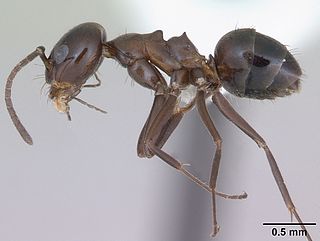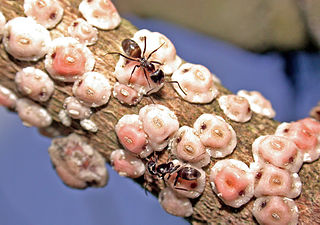
Messor is a myrmicine genus of ants with more than 100 species, all of which are harvester ants; the generic name comes from the Roman god of crops and harvest, Messor. The subterranean colonies tend to be found in open fields and near roadsides, openings are directly to the surface. The genus Vessomessor was recently combined with Messor, adding eight more species.

Dorylus, also known as driver ants, safari ants, or siafu, is a large genus of army ants found primarily in central and east Africa, although the range also extends to southern Africa and tropical Asia. The term siafu is a loanword from Swahili, and is one of numerous similar words from regional Bantu languages used by indigenous peoples to describe various species of these ants. Unlike the New World members of the former subfamily Ecitoninae, members of this genus do form temporary anthills lasting from a few days up to three months. Each colony can contain over 20 million individuals. As with their New World counterparts, there is a soldier class among the workers, which is larger, with a very large head and pincer-like mandibles. They are capable of stinging, but very rarely do so, relying instead on their powerful shearing jaws.

Dolichoderinae is a subfamily of ants, which includes species such as the Argentine ant, the erratic ant, the odorous house ant, and the cone ant. The subfamily presents a great diversity of species throughout the world, distributed in different biogeographic regions, from the Palearctic, Nearctic, Afrotropical region and Malaysia, to the Middle East, Australian, and Neotropical regions.

Aphaenogaster is a genus of myrmicine ants. About 200 species have been described, including 18 fossil species. They occur worldwide except in South America south of Colombia, Sub-Saharan Africa, and Antarctica.

Crematogaster is an ecologically diverse genus of ants found worldwide, which are characterised by a distinctive heart-shaped gaster (abdomen), which gives them one of their common names, the Saint Valentine ant. Members of this genus are also known as cocktail ants because of their habit of raising their abdomens when alarmed. Most species are arboreal. These ants are sometimes known as acrobat ants.

Carebara is a genus of ants in the subfamily Myrmicinae. It is one of the largest myrmicine genera with more than 174 species distributed worldwide in the tropics and the Afrotropical region. Many of them are very tiny cryptic soil and leaf litter inhabitants. They nest in rotten wood to which the bark is still adherent in the Afrotropical region, or may be lestobiotic nesting near other ant species. Some species are known to exist parasitically within termite nests. Little is known about the biology of the species. However, they are notable for the vast difference in size between queens and workers.

Phrynoponera gabonensis is an Afrotropical species of ant in the subfamily Ponerinae. P. gabonensis is the most common, widely distributed and frequently encountered member of the genus Phrynoponera. Specimens are usually retrieved from leaf litter samples but also occur in pitfall traps. The species is known to nest in and under rotten wood, in compacted soil and in termitaries.

Leptomyrmecini is a tribe of Dolichoderinae ants with 16 genera and two extinct genera.

Bothriomyrmex saundersi is a species of ant in the genus Bothriomyrmex. Described by Santschi in 1922, the species is endemic to Portugal and Spain.

Dorymyrmex bituber is a species of ant in the genus Dorymyrmex. Described by Santschi in 1916, the species is endemic to Argentina and Paraguay.

Dorymyrmex brunneus is a species of ant in the genus Dorymyrmex. Described by Forel in 1908, the species is endemic to several nations in South America.
Dorymyrmex coniculus is a species of ant in the genus Dorymyrmex. Described by Santschi in 1922, the species is endemic to Argentina.

Dorymyrmex elegans is a species of ant in the genus Dorymyrmex. Described by Trager in 1988, the species is endemic to the United States and Mexico, where it is a nocturnal species and is normally seen on cool days.

Dorymyrmex grandulus is a species of ant in the genus Dorymyrmex. Described by Forel in 1922, the species is endemic to the United States.

Dorymyrmex paranensis is a species of ant in the genus Dorymyrmex. Described by Santschi in 1922, the species is endemic to Paraguay.
Dorymyrmex pulchellus is a species of ant in the genus Dorymyrmex. Described by Santschi in 1922, the species is endemic to Argentina.
Dorymyrmex santschii is a species of ant in the genus Dorymyrmex. Described by Gallardo in 1917, the species is endemic to Argentina.

Dorymyrmex spurius is a species of ant in the genus Dorymyrmex. Described by Santschi in 1929, the species is endemic to Argentina, Brazil, Paraguay and Uruguay.
Dorymyrmex steigeri is a species of ant in the genus Dorymyrmex. Described by Santschi in 1912, the species is endemic to Argentina and Uruguay.
















